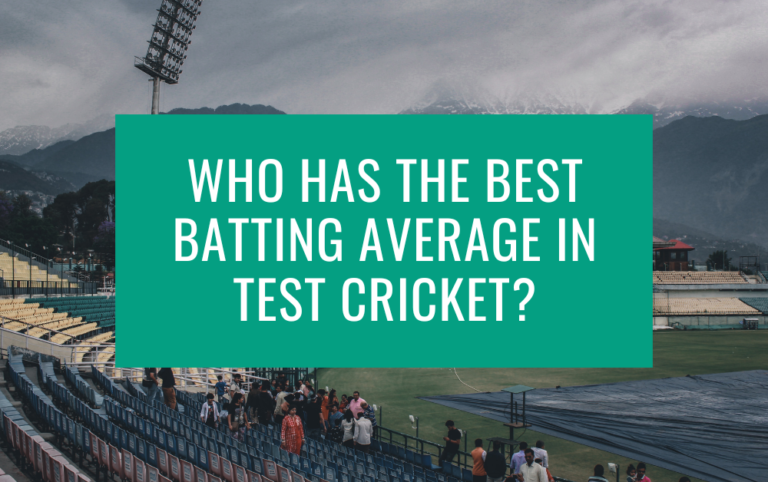For any cricketer, the weight of their bat is a crucial factor impacting their batting style and success. But exactly how heavy are cricket bats? What is the typical weight range? Are there regulations governing bat weight? This in-depth guide examines the standard bat weights used by professionals and amateurs alike.
Understanding the spectrum of cricket bat weight in pounds and kilos is useful when selecting the ideal heft tailored to your game. Let’s analyze the average cricket bat weight, light and heavy extremes, and regulations surrounding cricket bat mass.
The Typical Range of Cricket Bat Weight
Most standard adult cricket bat weight between:
- 2 pounds 6 ounces to 2 pounds 10 ounces (1.08 kg to 1.22 kg)
This is considered the standard weight range used by adult recreational and professional cricketers. Within this, the average cricket bat weight is:
- 2 pounds 8 ounces or 1.13 kg
So if you pick up a random cricket bat, chances are it will be around 2 lbs 8 oz or 1.13 kg, give or take 2-3 ounces. Variables like handle thickness, balance, materials and personalized weighting impact the small weight differences.
The Lightweight End of the Cricket Bat Weight Spectrum
At the lighter end, cricket bat weight can as little as:
- 2 pounds to 2 pounds 5 ounces (0.9 kg to 1.08 kg)
These super lightweight bats are popular among players with less upper body strength or injury concerns. Materials like carbon fiber allow reducing weight without compromising bat balance and power.
The Heavyweight End of the Cricket Bat Weight Range
Heavier bats popular with power hitters can range between:
- 3 pounds (1.36 kg) to 3 pounds 6 ounces (1.5 kg)
Some specialized heavy bats even approach 4 pounds (1.8 kg) to generate maximum hitting power for big strikers of the ball. But these are less common.
Are There Regulations on Bat Weight in Cricket?
Yes, the Laws of Cricket govern the legal weight range of bats used in professional matches:
- The bat cannot exceed 38 inches (96.5 cm) in length.
- Bat width is restricted to 4.25 inches (10.8 cm) at the widest part.
- No restrictions on overall weight but bats must have a sensible weight for their size.
- The umpires can ban any bat that gives a batter unfair advantage due to excessive weight.
So while no numeric weight limit is defined, umpires prohibit absurdly heavy bats that are bigger than the accepted size norms. Anything above 3 pounds 6 ounces is likely to attract scrutiny.
Why Do Players Use Different Bat Weights?
Batters choose different bat weights based on factors like:
- Their body strength and power to wield the bat optimally.
- Type of batting style – front foot vs back foot stroke play.
- Power hitting capability – heavier bats provide more hitting force.
- Control and stability through the shot – lighter bats may offer more finesse.
- Arm and shoulder strength to swing the bat repetitively during innings.
So optimizing bat weight helps generate the ideal balance between swing speed, precision and momentum through your shots.
How Do You Find the Right Bat Weight?
Some tips when finding your optimum bat weight:
- Try a range of weights between 2 lbs 6 oz to 3 lbs 2 oz (1.1 kg – 1.4 kg).
- Assess swing control and impact on power with different weights.
- See if you can use the entire bat face comfortably with your chosen weight.
- Ask a coach to evaluate your shots with different bat weights.
- Test bats of friends/teammates to get more weight options.
- Build strength first before moving to a very heavy bat just for power.
- Choose a weight fit for your natural swing – speed vs stability.
The perfect bat weight balances your strength, technique and shot-making strategy. Mastering weight selection helps unlock your full batting potential.
Explore a detailed analysis of the best batting averages in cricket and how bat weight influences performance at CricHD’s Analysis of Batting Averages.
So in summary, while 2 pounds 8 ounces is the average bat weight, professional cricketers can choose between a range of options from featherlight to heavyweight depending on personal preference and game strategy. Finding your optimal balance through trial and error is key.
Why Bat Weight Matters in Cricket
The cricket bat weight significantly affects a player’s performance. It influences bat swing, timing, and ultimately, the ability to hit the ball effectively. Lightweight bats offer ease of maneuverability, while heavyweight bats provide more power. This section explores how the bat’s weight impacts these key aspects of batting.
Choosing the Right Weight Cricket Bat
Selecting the ideal bat weight is a subjective decision, influenced by a player’s strength, batting style, and personal preference. A heavy bat might offer more power but could compromise on timing for some, while a light bat might enhance stroke play but lack the force behind the shots.
The Evolution of Bat Weights in Cricket
Cricket bats have evolved significantly over the years, with changes in materials, design, and, importantly, weight. This historical overview showcases how bats have transformed from the heavy willow of yesteryears to the varied weights available today.
How Bat Weights Have Changed
In the early days of cricket, bats were significantly heavier. However, advancements in technology and changes in playing styles have led to a wider range of bat weights. This evolution reflects the dynamic nature of the sport and its adaptation to modern playing techniques.
The Physics Behind Weight of Your Cricket Bat
Understanding the physics of bat weight is essential to comprehend its influence on the game. This section delves into the science of momentum, swing speed, and impact force, illustrating how different weights can alter these dynamics.
Impact of Weight on Bat Speed and Power
Heavier bats might generate more power due to increased momentum, but they can also slow down bat speed. Conversely, lighter bats enhance speed but might reduce the force of impact. Balancing these factors is key to choosing the right bat.
Weights of Professional Cricketers’ Bats
Ever wondered about the bat weights preferred by cricket legends? This section provides insights into the bat weights used by renowned cricketers like Virat Kohli, MS Dhoni, and Sachin Tendulkar.
Cricket Legends and Their Bat Weights
Famous cricketers often have preferred bat weights that complement their playing styles. For instance:
- Virat Kohli: Known for his impeccable timing and wrist work, Kohli often opts for a bat weighing around 1.1 kg (2.4 lbs), balancing power and control.
- MS Dhoni: Famous for his powerful hitting, Dhoni’s bat weighs around 1.25 kg (2.75 lbs), aiding his hard-hitting style.
- Sachin Tendulkar: Tendulkar, a master of both power and precision, used bats around 1.2 kg (2.6 lbs), offering a blend of control and ability to play big shots.
Insights from the Pros
Learn from the pros as we delve into the specifics of their bat choices. This comparative analysis reveals how professional cricketers select their bats based on weight and how it complements their playing style.
Heavyweight Cricket Bat Vs. Lightweight Cricket Bat: What to Choose Heavyweight Bat Or Lightweight Bat
This comprehensive comparison weighs the advantages and disadvantages of using heavy and light bats in various cricket formats. From Test cricket’s endurance to T20’s explosiveness, understand how bat weight influences performance in each format.
Making the Right Choice for Your Game: Heavy or Light
Choosing between a heavy or light bat depends on numerous factors, including the format of cricket, the batsman’s role, and individual preference. This section provides guidance on making an informed choice that suits your style and objectives.
The Ideal Weight of the Bat for Different Playing Styles
Batsmen come in all forms – from aggressive hitters to technical stroke players. This part of the article explores how bat weight should vary depending on a batsman’s playing style and objectives.
Tailoring Bat Weight to Your Style
Whether you’re a power hitter or a finesse player, selecting a bat that complements your style can significantly impact your effectiveness on the field. Tips and advice on aligning bat weight with playing style are provided here.
How to Measure and Choose Your Bat Weight
A practical guide on how to measure and choose the right bat weight. This section includes steps and tips to ensure that players can make an informed decision when selecting their cricket bat.
Tools and Techniques for Accurate Measurement
Learn about the tools and techniques for measuring bat weight and balancing it with your strength and technique. This practical advice ensures that players can feel confident in their bat selection process.
Common Myths About Weight of a Cricket Bat
Debunking common myths about cricket bat weight helps players make more informed decisions. This section clears up misconceptions and provides factual information to guide players in their selection.
Separating Fact from Fiction
From myths about heavier bats always being better to misconceptions about cricket bat weight and power, this section clarifies common misunderstandings and presents the facts.
Summary: Key Takeaways on Cricket Bat Weight
In conclusion, the cricket bat weight is a critical element that can greatly influence a player’s performance. Understanding the balance between weight, power, and control is essential for every cricketer, regardless of their level of play. Here are the most important points to remember:
- The choice between a heavy and light bat depends on personal preference, playing style, and the format of cricket.
- The evolution of cricket bats has led to a wide range of weights, catering to different types of players.
- Professional cricketers choose their cricket bat weight carefully, considering their style and the demands of the game.
- Measuring and choosing the right cricket bat weight is crucial for optimal performance.
- It’s essential to separate myths from facts when it comes to cricket bat weight.
Understanding the significance of cricket bat weight offers a deeper appreciation of the sport and can help players at all levels enhance their game.
For more insights into cricket equipment and game strategies, visit CricHD





